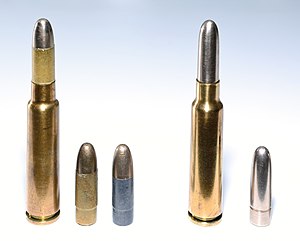7.5 mm GP 90
| 7.5 mm GP 90 | |
|---|---|
| general information | |
| caliber | 7.5 mm GP 90 |
| Sleeve shape | rimless with pull-out groove |
| Dimensions | |
| Sleeve length | 53.5 mm (GP 90, GP 90/03) or 54.5 (GP 90/23) mm |
| Weights | |
| Technical specifications | |
| Lists on the subject | |
The 7.5 mm GP 90 is a rifle cartridge introduced into the Swiss Army in 1890 .
Executions
It was developed by Eduard Rubin and used for the Schmidt-Rubin rifles of the 1889 model series. It was the first cartridge with low-smoke powder used by the Swiss Army .
The bullet in the GP 90 cartridge was a lead bullet with a steel cap. There were lead bullets, the exposed part of which was wrapped in paper to protect against corrosion. The GP 90/03 version contained a non-corrosive, mercury-free primer . The GP 90/23 was developed for use in weapons with the caliber 7.5 mm GP 90 and 7.5 × 55 mm Swiss (GP 11).
Other names
The rifle cartridge 90 does not have an internationally uniform marking, since the cartridge was designed before the founding of the CIP (1914) and also the SAAMI (1929) and there is no need for a subsequent directive for this Swiss military cartridge, which was already obsolete at the beginning of the 20th century more existed.
- GP 90 (rifle cartridge 90 - not to be confused with the Swiss Gw Pat 90 in caliber 5.56 × 45 mm from 1990)
- Rifle cartridge Ordonnance 1889
- GP 1890
- 7.5 x 53.5 mm
- 7.5 x 54.5 mm
- 7.5 mm Schmidt-Rubin GP 90
literature
- Christian Reinhart, Michael Am Rhyn, Kurt Sallaz: The repeating rifles of Switzerland: The Vetterli and Schmidt-Rubin systems. Publishing house Stocker-Schmid, Dietikon 1991.
Web links
Individual evidence
- ^ Franco Widmer: Trial cartridges. In: ch-munition.ch. Cartridge Collectors Association V., accessed on June 6, 2015 .
